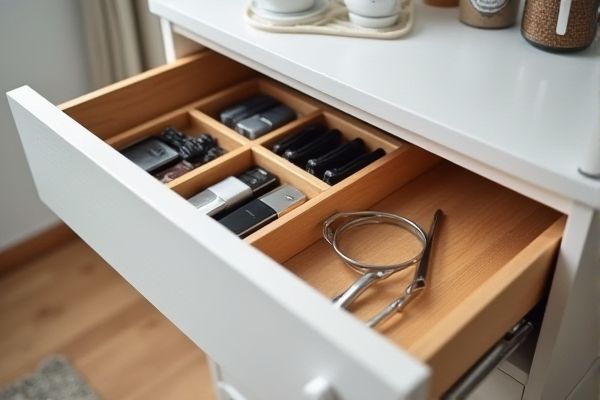
A drawer divider efficiently segments your storage space to keep items neatly separated, while a tray organizer typically provides compartments on a flat surface for easier access and visibility of smaller objects. Explore the following insights to determine which solution best suits your organizational needs and enhances Your daily routine.
Table of Comparison
| Feature | Drawer Divider | Tray Organizer |
|---|---|---|
| Purpose | Separates items within a drawer to maximize space. | Organizes items on flat surfaces like desks or countertops. |
| Material | Wood, plastic, metal, or fabric. | Plastic, bamboo, wood, or metal. |
| Adjustability | Often adjustable or expandable to fit various drawer sizes. | Fixed compartments, limited adjustability. |
| Installation | Usually non-invasive; slides or fits inside drawers. | Placed directly on surfaces; no installation required. |
| Best For | Cutlery, office supplies, small clothing items. | Jewelry, cosmetics, stationery, small tools. |
| Portability | Less portable; designed to stay inside drawers. | Highly portable for use in multiple locations. |
| Space Efficiency | Maximizes drawer space with minimal footprint. | Optimizes flat surface area but takes up visible space. |
Introduction to Drawer Dividers and Tray Organizers
Drawer dividers and tray organizers both enhance space efficiency by customizing storage within drawers but serve distinct purposes. Drawer dividers create adjustable compartments by segmenting larger drawer spaces, ideal for separating bulky items or keeping utensils orderly. Tray organizers consist of fixed sections designed to hold smaller items like jewelry or office supplies, offering quick access and preventing clutter.
Key Differences Between Drawer Dividers and Tray Organizers
Drawer dividers create adjustable compartments by separating larger spaces, ideal for customizing your drawer layout, while tray organizers offer fixed sections designed for specific items like utensils or office supplies. Drawer dividers maximize flexible use by expanding or contracting to fit dimensions, whereas tray organizers provide structured organization with dedicated slots. Choosing between the two depends on whether you need adaptability in your drawer or permanent segmented storage.
Benefits of Using Drawer Dividers
Drawer dividers maximize storage efficiency by creating separate compartments within drawers, reducing clutter and making it easier to locate items quickly. They provide customizable organization for various drawer sizes and contents, from utensils to office supplies, enhancing overall tidiness and accessibility. By preventing items from shifting during drawer use, drawer dividers help maintain an orderly space, improving both functionality and aesthetics.
Advantages of Tray Organizers
Tray organizers maximize drawer space by creating multiple compartments that keep items neatly separated and easily accessible. They help prevent clutter and make it simpler for you to quickly locate utensils, office supplies, or makeup essentials. Their versatile design fits various drawer sizes, enhancing overall organization and efficiency.
Material and Design Comparison
Drawer dividers are typically made from durable materials such as wood, bamboo, or sturdy plastic, designed to fit snugly within drawer dimensions and create adjustable compartments. Tray organizers often use lightweight plastic, silicone, or metal mesh, featuring fixed sections or removable inserts optimized for easy access and lightweight handling. The design of drawer dividers emphasizes customizable space segmentation, whereas tray organizers focus on compartmentalized storage with visually accessible layouts.
Best Uses for Drawer Dividers
Drawer dividers excel at creating customizable compartments within deep or large drawers, ideal for organizing bulky kitchen utensils, office supplies, or clothing accessories. They maximize space efficiency by preventing items from shifting, making it easy to find and access your belongings quickly. If you need to transform a messy drawer into a well-structured storage area, drawer dividers provide an adaptable solution tailored to your specific organizational needs.
Ideal Applications for Tray Organizers
Tray organizers are ideal for compartmentalizing small items like utensils, office supplies, or makeup, providing easy access and preventing clutter. They work best in shallow drawers where visibility and quick retrieval are essential. Their segmented design allows for efficient categorization, making them perfect for kitchens, desks, and vanity drawers.
Installation and Maintenance Tips
Drawer dividers typically feature adjustable or expandable designs that fit directly into your drawers without requiring tools, making installation quick and hassle-free. Tray organizers often come with fixed compartments and may need extensive measuring for a proper fit, but they are easy to clean by simply lifting out and washing. For maintenance, regularly wiping down drawer dividers ensures dust and debris don't accumulate, while tray organizers benefit from periodic removal and thorough cleaning to maintain hygiene and organization.
Cost Considerations: Drawer Divider vs Tray Organizer
Drawer dividers typically offer a more cost-effective solution, as they are often simple, adjustable inserts made from affordable materials like plastic or wood. Tray organizers, while sometimes more expensive due to their rigid design and multiple compartments, provide structured organization that can justify the higher price for those seeking specific storage needs. Your choice depends on balancing budget constraints with the level of organization desired in your drawers.
Choosing the Right Organizer for Your Needs
Choosing between a drawer divider and a tray organizer depends on the specific storage needs and available drawer space. Drawer dividers are ideal for creating customizable compartments to separate larger items or tools, while tray organizers offer predefined sections suitable for small items like cutlery or office supplies. Evaluating the types of items and frequency of access will help determine which organizer maximizes efficiency and keeps drawers tidy.
 homyna.com
homyna.com